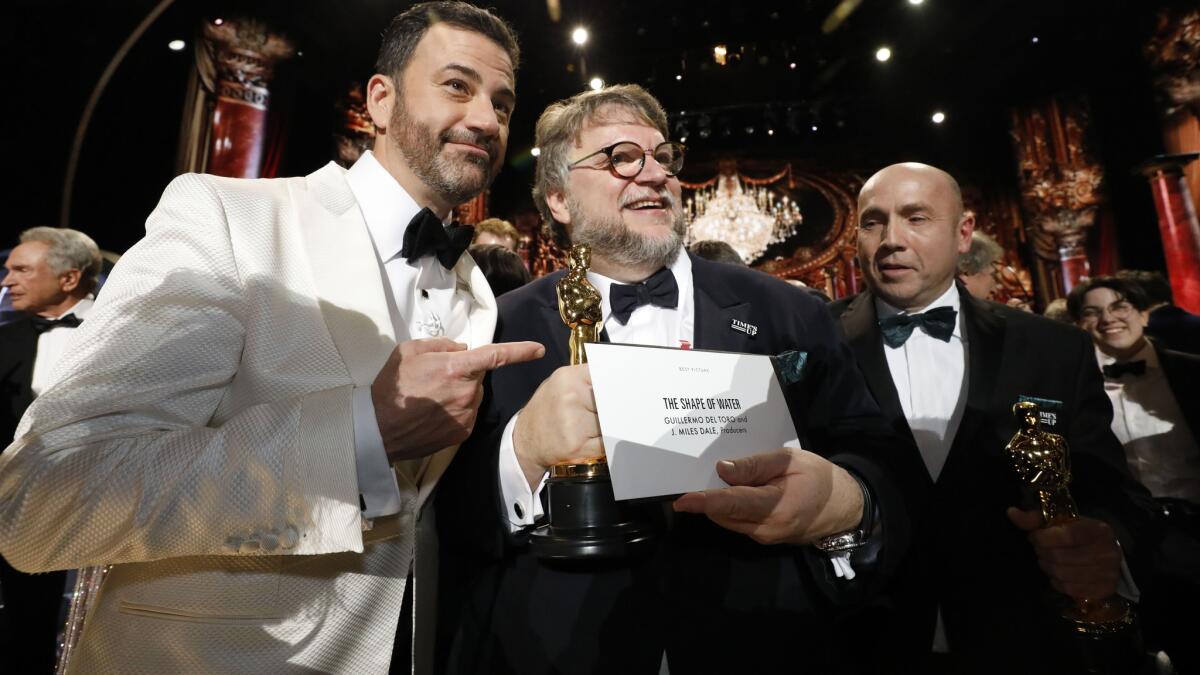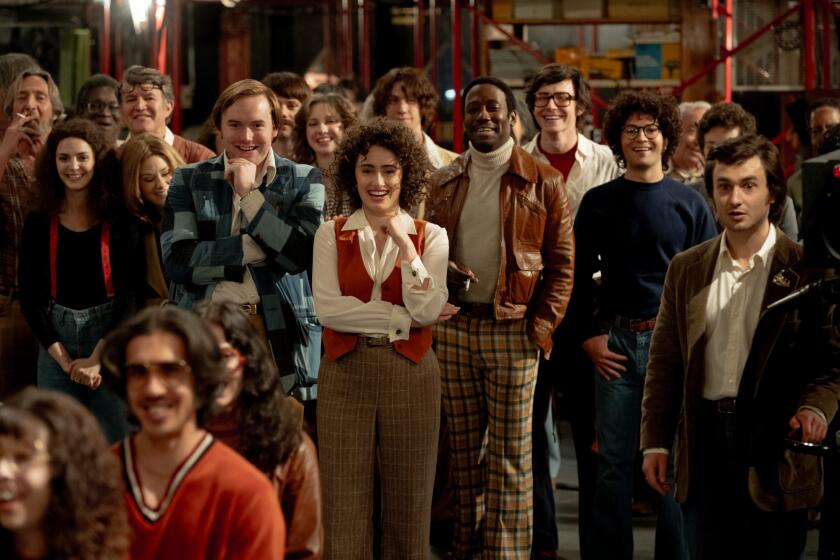Facing declining Oscars ratings, motion picture academy announces creation of new ‘popular film’ category

It’s safe to assume that few in Hollywood woke up Wednesday morning thinking that the Oscars as they knew them were about to change forever.
With no prior warning or public fanfare, the Academy of Motion Picture Arts and Sciences — a 91-year-old institution that proudly cherishes its traditions — announced a series of moves that could shake up the very nature of the Academy Awards, including the types of films nominated and the length of the telecast, instituting some of the most dramatic changes to the vaunted awards show in its history.
Among the three changes, which were approved by the 54-member board of governors and announced to the organization’s members in a brief letter, the most consequential and controversial one is the creation of a category for “outstanding achievement in popular film” that would stand apart from the traditional best picture award.
The announcement comes as the academy struggles with declining ratings for its Oscars telecast, which plummeted to an all-time low this year. The changes are also a clear effort to address the perennial criticism that the show itself has grown too bloated, too tedious and too out of touch with the interests and tastes of many mainstream moviegoers.

Although the academy has always held itself up as the standard bearer for cinematic excellence regardless of box-office performance, the new category clearly represents an effort to recognize broadly appealing and critically acclaimed commercial blockbusters — including superhero movies such as “Wonder Woman” — that even with the expansion of the best picture category to include as many as 10 films have often failed to make the cut.
The addition of this category, which will be introduced at next year’s Oscars, could open up fresh possibilities for such critically lauded studio crowd-pleasers as “Mission: Impossible — Fallout” and “A Quiet Place,” as well as “Black Panther,” which had already been considered a viable best picture candidate.
But if the academy hoped to end the blood sport of Oscars trashing on social media, the attempt backfired. The announcement of the new category sparked immediate criticism, with many calling it an act of pandering in search of ratings that will water down the significance of the awards themselves.
“[A ‘popular film award’] is a ghetto and will be perceived that way,” film historian and commentator Mark Harris wrote on Twitter. “Imagine ... ‘Oh, it’s lovely that the rabble went to “Black Panther” — here’s a special fake Oscar it can win!’ This is just a head-slapper on all counts.”
“The film business passed away today with the announcement of the ‘popular’ film Oscar,” longtime academy member Rob Lowe wrote on Twitter. “It had been in poor health for a number of years. It is survived by sequels, tent-poles, and vertical integration.”
The definition of what constitutes a “popular film” is at this point unclear. In its letter, the academy simply said that “eligibility requirements and other key details will be forthcoming.”
In an email to The Times, an academy representative clarified that a movie could be eligible for Oscars in both the popular film and best picture categories, writing that: “In creating this award, the Board of Governors supports broad-based consideration of excellence in all films.”
Though various ways to improve the show and boost its ratings have long been discussed, the academy’s move caught even many Oscar insiders unawares.
“This isn’t the way you normally announce things,” observed a veteran awards consultant and member of the academy’s public relations branch who spoke on condition of anonymity because of the sensitive nature of the topic. “The stunning lack of details suggest how poorly thought out the whole thing is.”
Although massive hits like “Titanic,” “The Lord of the Rings” films and “Get Out” have earned best picture nominations or wins, the race recently has been dominated by smaller films such as the last two honorees, “Moonlight” and “The Shape of Water.”
In a scathing letter announcing his resignation from the board of governors earlier this year, producer and former studio executive Bill Mechanic bemoaned this state of affairs. “[O]ver the past decade we have nominated so many smaller independent films that the Oscars feel like they should be handed out in a tent,” he wrote. “Big is not inherently bad and small is not inherently good.”
This isn’t the first time the academy has pushed to include box office hits at the Oscars. The group expanded the number of best picture nominees from five to 10 in 2009 after voters ignored Christopher Nolan’s acclaimed Batman movie, “The Dark Knight,” the previous season.
Oscar ballots had 10 spots for best picture in the 2009 and 2010 ceremonies, resulting in nominations for popular movies like “Inception” and “District 9” and Pixar’s lauded “Up” and “Toy Story 3.” But some academy members believed the expansion diluted the category’s prestige, and in 2011, the best picture rules were changed again to the current system. Voters now list only five movies on their ballots, and a complicated math system determines a variable number of nominees.
Since that time, no animated movie has been nominated for best picture, and some academy members believe voters marginalize the movies, relegating acclaimed pictures like “Inside Out” to the animated feature category, created in 2001.
“It does feel like voters see the separate category and feel like that’s reward enough,” then-Pixar producer Darla K. Anderson told The Times in a 2009 interview.
Similarly, many see the popular film Oscar as a way of marginalizing popular movies.
“How can it feel like anything less than a consolation prize?” asked a longtime awards campaigner who requested anonymity because of the possibility of professional repercussions.
Responding to years of criticism that the telecast frequently runs too long — often pushing well past three hours, with the longest, in 2002, clocking in at an epic four hours and 23 minutes — the academy also announced that it would limit the show to three hours and move the presentation of certain awards to commercial breaks during the program. “The winning moments will then be edited and aired later in the broadcast,” the academy noted, without specifying which categories this change would apply to.
Although many viewers have long complained about the number of less widely accessible awards in the show, including those for sound editing, sound mixing and short films, their inclusion has been important to members of the academy’s below-the-line branches, who have resisted suggestions over the years that they be moved to a separate ceremony.
In 1992, for instance, the board of governors voted to remove the live-action short film and documentary short-film categories from the ceremony. High-profile academy members like Steven Spielberg, Martin Scorsese and Robert Redford protested, and the move was reversed, never going into effect.
Lastly, the academy announced it is moving up the date of the 92nd Oscars telecast by two weeks, from the previously announced Feb. 23, 2020, to Feb. 9, 2020. The move presumably represents an effort to address the awards fatigue that can set in over the course of a prolonged awards season, sapping audiences’ interest in the Academy Awards. The 91st Oscar telecast remains as announced on Feb. 24, 2019.
In 2016, the academy and ABC renewed their domestic TV rights deal for an additional eight years, keeping the Oscar telecast on the network through 2028. As it faces the same ratings headwinds as many other shows across the TV landscape, the academy has been under pressure to try to halt the viewership erosion.
The alterations to the show come against the backdrop of years of unprecedented change — and frequent tumult — at the academy, which after weathering two years of #OscarsSoWhite controversy has vastly swelled its membership in an effort to diversify its historically overwhelmingly white and male ranks. The academy is also in the midst of an ambitious and expensive effort to build a museum in the heart of Los Angeles that has placed new pressures on its finances.
For now, the changes raise as many or more questions than they answer. But the academy’s leadership promises that more clarity will be forthcoming.
“We have heard from many of you about improvements needed to keep the Oscars and our Academy relevant in a changing world,” the academy’s newly re-elected President John Bailey and Chief Executive Dawn Hudson wrote in the letter. “We are excited about these steps, and look forward to sharing more details with you.”
For his part, Mechanic applauded the changes in an email to The Times on Wednesday.
“This is the first major change in the Oscar presentation in many years and represents a very positive step forward,” he wrote. “There may be more work to be done, but the streamlining of the telecast will make it way better paced, the addition of a mainstream category gives more film fans a rooting interest, and the date change helps slightly to keep the process fresher given all the other award shows. I know how hard it is within the organization to create change, so I really applaud John, Dawn and the Governors for this step forward.”
Twitter: @joshrottenberg
UPDATES:
4:03 p.m.: This article was updated with additional details.
12:46 p.m.: This article was updated with reactions, analysis and additional information about the new “popular film” category.
5:09 p.m.: This article was updated with more reactions to the academy’s Oscars changes.
This article was originally published at 11:30 a.m.
More to Read
Only good movies
Get the Indie Focus newsletter, Mark Olsen's weekly guide to the world of cinema.
You may occasionally receive promotional content from the Los Angeles Times.












